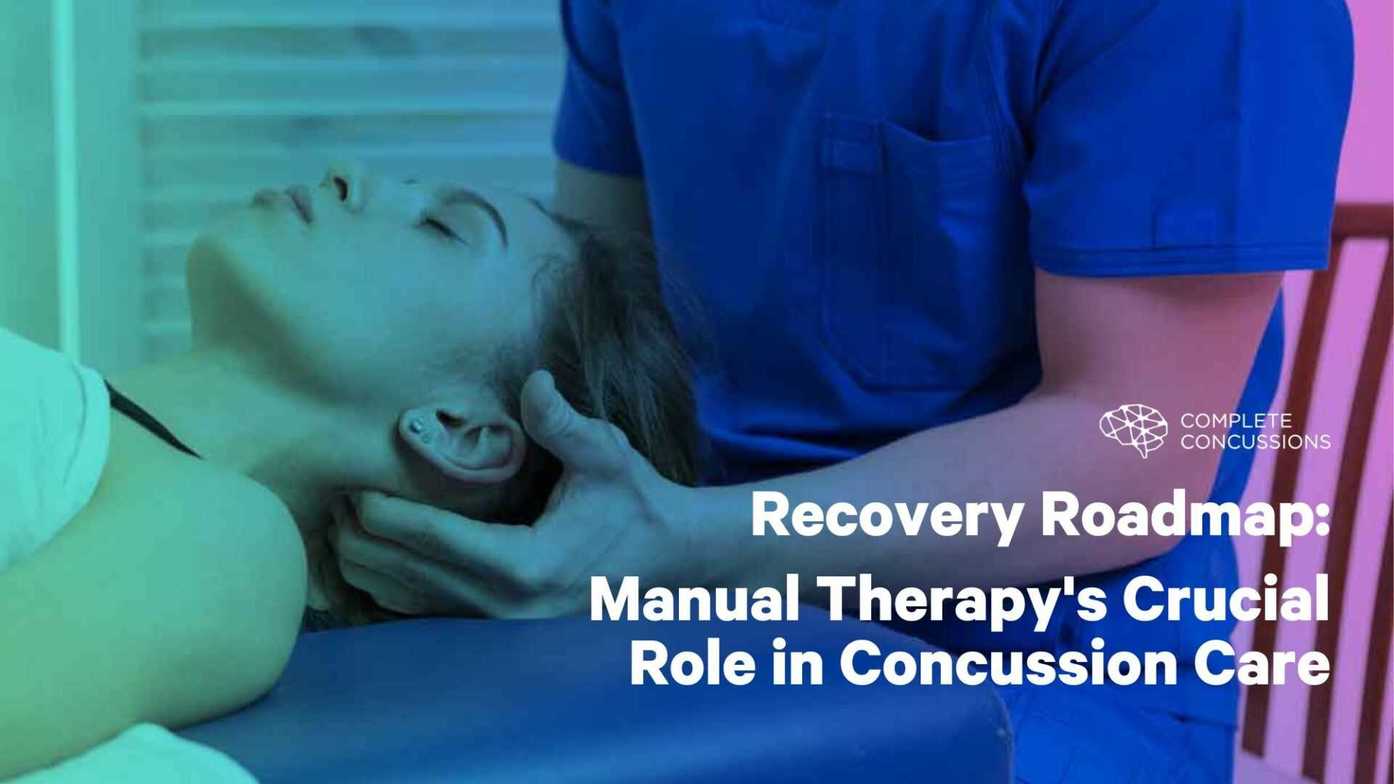Recovery Roadmap: Manual Therapy’s Crucial Role in Concussion Care
|
|
| |
|
|
In the ever-evolving landscape of concussion management, the profound influence of manual therapy techniques on patient outcomes is indisputable.
The nuanced practice of manual therapy has, at times, been overlooked in healthcare practices. With the advent of remote treatment modalities, shortening treatment times, and a decline in hands-on care, the intricate art of manual therapy is fading. Techniques encompassing joint manipulation, soft tissue manipulation, dry needling, acupuncture, and postural stability rehabilitation have significant positive implications for patients’ overall recovery from concussion injuries and post-concussion syndrome.
Our understanding of concussions has evolved significantly, leading to a profound change in how we approach recovery. It’s now clear that adopting a well-rounded approach to care offers the most promising results. Manual therapy techniques play a crucial role in this holistic approach, addressing various aspects of the body. They can help reduce visual problems, improve cognitive function, restore flexibility, and alleviate pain.
In this article, we will discuss the vital role that manual therapy plays in the field of concussion care. Furthermore, we introduce a collection of techniques designed to empower healthcare professionals with the essential resources to aid patients in their recovery journey after experiencing a concussion injury.
|
|
|
Concussion A Functional Injury
|
|
A widespread misconception is that any head or body impact equates to a concussion. In reality, a specific degree of force, quantified in gravitational force (G-Force), is required to induce such an injury—typically within a range of 70-120 Gs (1). However, whiplash injuries, also termed cervical spine sprain/strain, occur with far lower force levels, usually around 4.5 Gs.
This stark contrast emphasizes the importance of considering the cervical spine in the context of managing post-concussion syndrome. A study by Marshall et al, investigated this very comparison, analyzing two groups of patients: one diagnosed with a concussion and the other with a cervical spine injury. Interestingly, the study found that based solely on the reported symptoms, it was impossible to distinguish between the two groups (2).
Concussions do not cause structural damage to the brain but rather result in functional deficits. One lingering functional deficit that can extend beyond our desired recovery timeframe is an additional injury to the cervical spine. The cervical spine and other closely related musculoskeletal regions of the body such as the thoracic spine have the ability to affect multiple areas of perceived concussion functional disturbances.
|
|
|
Common symptoms that have been clinically shown to be associated with cervical spine dysfunction,
|
|
- Cognitive Fatigue
- Visual Disturbances
- Vestibular Dysfunction such as Dizziness/ Vertigo
- Difficulty Concentration
- Headache
- Eye pain
The cervical spine and surrounding musculoskeletal regions have the greatest ability to positively be treated with manual therapy techniques.
|
|
|
|
|
|
When conducting physical examinations on the cervical spine and surrounding regions of PCS individuals, certain common dysfunctions surface. These include joint restrictions and trigger point referral patterns.
Joint restrictions, stemming from immobility, can lead to tension, stiffness, and neck discomfort. Conversely, trigger points are a natural physiological response, often emerging as a protective mechanism after an acute injury, particularly in muscles lacking stability. Intriguingly, both joint restrictions and trigger points share similarly reported symptoms. That is why it’s important to conduct a thorough exam to determine the involvement between functional findings following a head injury.
Assessment of the Musculoskeletal system following a concussion include.
- Joint Palpation: Skillful palpation for joint motion.
- Soft Tissue Assessment: Evaluating the condition of soft tissues.
- Postural Stability/ Motor Control: Analyzing postural stability and motor control.
Effective examination techniques that encompass joint motion palpation, soft tissue assessment, and the identification of postural stability dysfunction can significantly enhance the efficacy of manual therapy interventions aimed at treating the dysfunctions of the musculoskeletal system.
|
|
Common Manual Therapy Techniques for Concussion Treatment
|
|
|
|
|
|
Joint manipulation is a highly effective and potent approach for addressing joint dysfunction. Following an injury, joints in the cervical spine often suffer from stiffness and impaired mechanics, resulting in reduced range of motion, headaches, and neck pain.
Our neck muscles and joints house receptors that inform the brain about our spatial orientation. When this mechanism is compromised, it can cause dizziness and disturbances in balance. employ techniques derived from them to restore optimal joint motion. We first conduct a thorough assessment of a joint range of motion and movement quality to identify any restrictions.
Once these dysfunctions are identified through motion palpation or feeling for “Joint Play” the perceived feeling of joint motion, the trained clinician can gently apply an HVLA (High Velocity Low Amplitude) manipulation to the joint, reinstating proper mechanics and reduce overall symptoms.
|
|
|
Soft Tissue Dysfunction:
Treatment- Soft Tissue Manipulation, Acupuncture, and Dry Needling
|
|
After sustaining an injury, our body instinctively adopts a protective pattern, a remarkable mechanism designed to shield us from potential harm. This pattern is characterized by heightened stiffness, pain, and a restricted range of motion. While this adaptive response is advantageous in genuinely perilous situations, it can impede daily life activities.
This protective response is often marked by the formation of “trigger points” within the muscles surrounding the affected area. In the context of a concussion injury, it is commonplace for patients to develop trigger points in the muscles of the cervical spine. These trigger points have the capacity to elicit pain in other areas of the body, a phenomenon known as Sclerotogenous pain referrals. This phenomenon provides the rationale for the treatment of soft tissue in the cervical spine to alleviate conditions like headaches, eye discomfort, and jaw pain, among others.
Within manual therapy, a common technique for addressing trigger points and hypertonic musculature is soft tissue manipulation. Two widely recognized techniques in the chiropractic and physical therapy realms are ART (Active Release Techniques) and fascial manipulation. Both approaches excel in reducing tension and tone within the musculoskeletal system.
Additionally, practitioners may employ acupuncture and dry needling as alternative modalities. The use of needling for pain reduction is popular today among physical therapists, chiropractors, and athletic trainers. A study by Berger et al showed that dry needling can be an effective tool in the immediate reduction of neck pain. This may be due to the effect dry needling has on the trigger points. (3)
A systematic review of the effectiveness of dry needling for myofascial trigger points associated with neck pain symptoms showed dry needling is a safe and affect tool that improves pressure pain threshold in individuals with active trigger points. (3,4)
|
|
|
Commonly affected soft tissue structures and their commonly associated sclerotogenous referrals include
|
|
- Sternocleidomastoid Muscle- Fascial pain or mastoid pain
- Sub-occipitals- Front of head pain
- Trapezius- Temporal or jaw pain
- Semispinalis Capitis- Band-like pain
- Longus Colli- Suboccipital pain
|
|
|
Global Postural Function:
The Origins of Trigger Points and Joint Dysfunction
|
|
Postural changes can ensue after an acute injury, similar to the scenario discussed earlier. Our bodies may respond with heightened tone and tension, resulting in the development of trigger points around the affected structures, alongside joint restrictions and discomfort.
Over time, these postural alterations can exacerbate trigger points and joint limitations. While the aforementioned techniques, such as joint and soft tissue manipulation, prove effective in addressing dysfunction, the root causes of postural changes and motor control issues often remain unaddressed.
Rehabilitation techniques can serve as integrated tools within manual therapy, offering assistance in correcting the synergistic activation of muscles within the musculoskeletal system specifically around the cervical spine. This addresses the fundamental and shared origins of joint restrictions and soft tissue trigger points. By effectively guiding patients in adopting proper stabilization strategies, we lay the groundwork for restoring overall function.
|
|
|
|
|
|
In the ever-evolving landscape of concussion management, the profound influence of manual therapy techniques on patient outcomes is indisputable. These techniques, practiced by skilled manual therapists, have the potential to reshape the trajectory of recovery for those affected by traumatic brain injuries.
Following a mild traumatic brain injury, cervical spine joints often become rigid and suffer impaired mechanics (5), leading to reduced range of motion, headaches, and neck pain. The importance of proper joint mechanics extends to visual symptoms, as these joints house receptors crucial for spatial orientation. Healthcare professionals adept in evidence-based joint manipulation play a pivotal role in reinstating proper joint function, potentially expediting recovery and minimizing debilitating symptoms.
Furthermore, manual therapists recognize the intricate web of referred pain triggered by trigger points within the cervical spine muscles. These trigger points can often cause pain in distant parts of the body, a phenomenon well-documented in the field. Although patients may attribute such pain solely to brain function, experts have extensively cataloged numerous referral patterns. Fortunately, rehabilitation exercises provide a sustainable, long-term solution for alleviating pain originating from these trigger points.
The intricate interplay between head injuries and cervical spine issues underscores the need for comprehensive post-concussion syndrome (PCS) management. By addressing cervical spine dysfunctions through manual therapy, healthcare providers hold the potential to alleviate symptoms, enhance mobility, and facilitate overall recovery.
In conclusion, After a serious injury manual physical therapy has the ability to decrease pain and relief concussion symptoms. Manual therapy is a cornerstone in the journey to recovery following brain injuries, offering hope, relief, and a pathway toward restoring normalcy to the lives of those affected. The cumulative effects of manual therapy techniques, alongside other medical interventions, have the power to change lives and improve the well-being of patients on their road to recovery from concussions and traumatic brain injuries.
|
|
|
|
- Broglio SP, Eckner JT, Kutcher JS. Field-based measures of head impacts in high school football athletes. Curr Opin Pediatr. 2012;24(6):702-708.
- Marshall CM, Vernon H, Leddy JJ, Baldwin BA. The role of the cervical spine in post-concussion syndrome. Phys Sportsmed. 2015;43(3):274-284.
- Berger AA, Liu Y, Mosel L, et al. Efficacy of Dry Needling and Acupuncture in the Treatment of Neck Pain. Anesth Pain Med. 2021;11(2):e113627.
- Lewit K. The needle effect in the relief of myofascial pain. Pain. 1979;6(1):83-90.
- Galea O, O’Leary S, Treleaven J. Cervical musculoskeletal and sensorimotor impairments 4 weeks to 6 months following mild traumatic brain injury: An observational cohort study. Musculoskelet Sci Pract. 2022;57:102490
- Shah JP, Thaker N, Heimur J, Aredo JV, Sikdar S, Gerber L. Myofascial Trigger Points Then and Now: A Historical and Scientific Perspective. PM R. 2015;7(7):746-761.
- Lewit K, Simons DG. Myofascial pain: relief by post-isometric relaxation. Arch Phys Med Rehabil. 1984;65(8):452-456.
|
|



